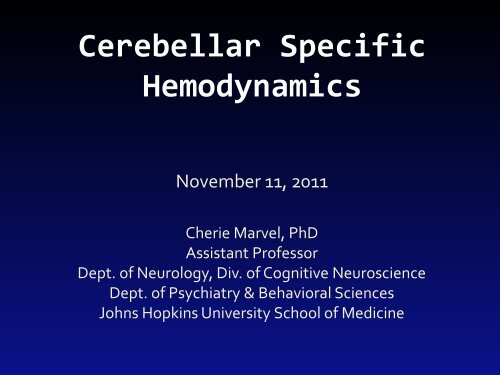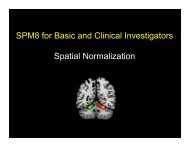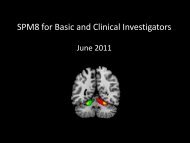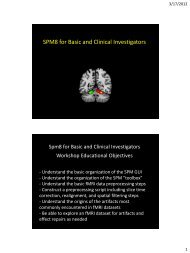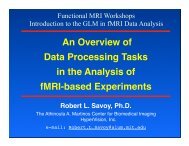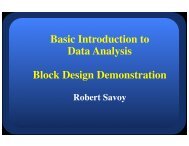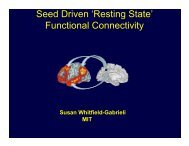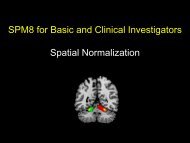Cerebellar Specific Hemodynamics - Neurometrika
Cerebellar Specific Hemodynamics - Neurometrika
Cerebellar Specific Hemodynamics - Neurometrika
- No tags were found...
You also want an ePaper? Increase the reach of your titles
YUMPU automatically turns print PDFs into web optimized ePapers that Google loves.
<strong>Cerebellar</strong> <strong>Specific</strong><br />
<strong>Hemodynamics</strong><br />
November 11, 2011<br />
Cherie Marvel, PhD<br />
Assistant Professor<br />
Dept. of Neurology, Div. of Cognitive Neuroscience<br />
Dept. of Psychiatry & Behavioral Sciences<br />
Johns Hopkins University School of Medicine
Overview<br />
I. Hemodynamic Response Function<br />
I. Definition<br />
II.<br />
Canonical vs. Customized<br />
II. How to obtain customized HRFs<br />
I. Finger tapping task<br />
II.<br />
Step x step guide using SPM8<br />
III. Example of group data results
Hemodynamic Response Function<br />
• Change in blood flow related to neural activity<br />
Blood flows to brain regions currently active<br />
Blood flow location related to task at hand<br />
Time course related to blood flow
2 eggs, ½ cup<br />
sugar, 1 tablespoon<br />
of butter…
Hemodynamic Response Function<br />
• Change in blood flow related to neural<br />
activity<br />
Blood flows to brain regions currently active<br />
Blood flow location related to task at hand<br />
Time course related to blood flow<br />
• Time course of HRF used in fMRI analyses
“Canonical” HRF Commonly Used
Does the same HRF apply to everyone<br />
• Males vs. females<br />
• Adults vs. children<br />
• Healthy vs. clinical<br />
• Individual variability
Customized HRF<br />
• 19 go/stop cycles, ~30 sec apart<br />
• 10 min task = 600 sec<br />
Chen & Desmond, Neuropsychologia, 2005
HRFs Determined by Motor Regions<br />
primary motor cortex<br />
anterior cerebellum<br />
• 19 go/stop cycles, ~30 sec apart<br />
• 10 min task = 600 sec<br />
Chen & Desmond, Neuropsychologia, 2005
HRFs Can Vary within the Brain
How-To Guide for Determining<br />
Custom HRFs Using SPM8
Motor<br />
Cortex<br />
Cerebellum<br />
Canonical
HRF Data are Convolved with<br />
Events of Interest<br />
0 0 0 1 0 0 0 0 0 0 1 0 0 1 o 0 0 1 0 0 ….
Motor HRF used as Regressor
<strong>Cerebellar</strong> HRF used as Regressor
Canonical HRF used as Regressor
Motor HRF used as Regressor
Example of Group Data Using Motor<br />
vs. <strong>Cerebellar</strong> HRF Regressors<br />
• N=16<br />
• Verbal working memory task:<br />
Mental rehearsal of letters<br />
No overt speech or movements<br />
Activations = contrast of high load minus low load
Motor Regressor
<strong>Cerebellar</strong> Regressor
Motor Regressor
<strong>Cerebellar</strong> Regressor
Summary<br />
• Customized HRFs can provide individualized<br />
data<br />
• Can refine the accuracy of fMRI results<br />
• Takes into account the possibility that the<br />
same HRF does not apply to everyone<br />
(potentially important for clinical studies)
Acknowledgments<br />
• John Desmond, PhD<br />
• Annabel Chen, PhD<br />
• Diana Liao, Hopkins undergraduate
The End


